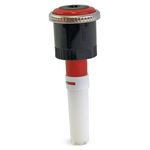
If you garden in a low-wind situation, your tall plants probably won’t need staking. However, my big, bold garden is out in the open prairie, so staking is often a necessity. Here are some of the things I’ve learned from experience. See our favorite picks for big, bold plants.
Go big from the start
There’s nothing more frustrating than having the wind take down a newly staked plant. Go bigger than you first think, and try to anticipate the final size that will be needed. You don’t want to be adding a new stake each month as the plant grows.
Rebar is an excellent option
I’ve used a variety of staking materials over the years based on what I could find or afford: wood, bamboo, metal conduit, and the green plastic-coated ones. The staking I would choose over all is rebar, the steel bar used to reinforce concrete. You can get whatever size you need, and it lasts forever. Plus, the dark rusty color blends into the background, so your stake isn’t the star of your garden.
Use sisal or jute twine for tying
Like rebar, these natural materials disappear into the background. I adjust the size of twine according to the weight and strength of the plant I am staking. I have tried the plastic tying tape, but it stretches and soon becomes ineffective. Leave the plants with a little give or lean; that looks more natural than a perfectly erect plant. As the plant grows, check to make sure that your tie is not girdling the stem. This is something I forget to do every darn time.
Irvin Etienne is curator of herbaceous plants and seasonal garden design at Newfields in Indianapolis.
Fine Gardening Recommended Products

XLUX Soil Moisture Meter

Hunter Industries MP-1000-90 Hunter Nozzle

Gilmore Rubber Hose Washer 10pk

















Comments
Log in or create an account to post a comment.
Sign up Log in